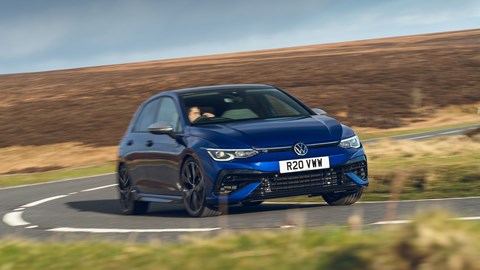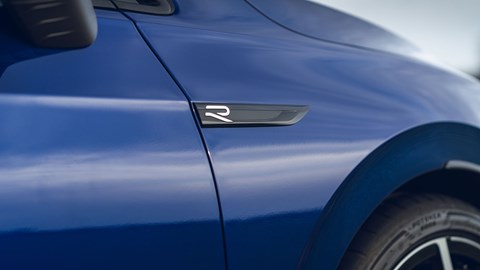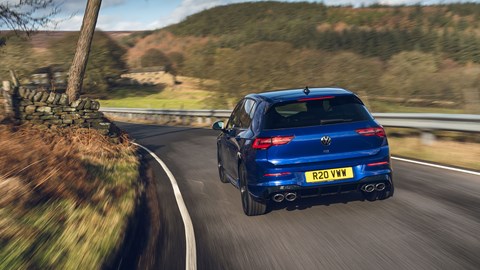► Decision confirmed by Volkswagen’s R boss
► R specs are being baked into next-gen EV platform
► Petrol and EV versions of the Golf R will co-exist
Reinhold Ivenz, boss of Volkswagen’s R division, has confirmed the brand will break into the electric car market within the next five years. We suspect the first electric car to wear R badging will be the Mk9 Golf, the standard version of which is expected to be unveiled in 2029.
During a roundtable interview, Ivenz told CAR magazine: ‘the future for us will be electric. It makes sense for us. In the moment, we look about the concepts – but for us it’s very important that the car is authentic also in the electric world. We will start, and we can say that in the next five years we will launch our first electric car.’
Despite his rather strict deadline, Reinhold also said he wouldn’t rush the R division into the EV market if the car produced by such a scramble wouldn’t be a true R model. He told us: ‘We say we’ll offer an electric car only if everything is okay for us.’
‘The acceleration, the performance, the sound is very important – the dynamic of the car and how it feels, how it looks like. It’s very important for us. So, we had always said in interviews that we will come with an [electric] car if everything is okay for us – and we don’t make an R-powered [electric] car which is not okay for us.’
What will the first R model look like?
Reinhold wouldn’t confirm the specifics, although he has ruled out a few ideas. For example, it doesn’t sound like Volkswagen will adopt the same combustion-mimicking approach as the Hyundai Ioniq 5 N for its electric performance cars.
Ivenz told us: ‘It’s a new generation. It makes no sense to copy the combustion engine. But you must find new R items which are very important for us.’ At the moment, the new R items Reinhold’s team seem to be focused on are software-driven features such as lap timers and 0–60mph trackers.
In fact, Jonas Thielebein, a development engineer for Volkswagen’s R division, took a rather dim view of Hyundai’s approach. He said: ‘You know how hard decisions are to make now on [gimmicks] like shifting an electric car and mimicking a combustion engine like some competitors.

‘But is it necessary to do this in four to five years? Or is it more to carry the customers over the transition from the combustion to the electric vehicles? Is it really necessary to develop it or does our customers wonder [why we bothered] in four or five years? That’s just one small piece of a big puzzle. It’s hard times, but very interesting times.’
Ivenz also told us there’s no chance that the Volkswagen R division will build its own bespoke model and separate from the Volkswagen brand in the same way Cupra severed itself from SEAT.
He said it was simply too expensive to either engineer his own platform for the project or try to piggyback development of the car off a more technologically advanced platform from another brand within the Volkswagen Group, such as Porsche.
Come on, then! What’ll this electric R model look like?
Alright, keep your hair on. There’s a lot to unpack here. The first electric R model will probably be based on the upcoming electric replacement for the Golf, which will be underpinned by the Volkswagen Group’s new SSP architecture.
This fresh platform will be crucial in bringing the R EV to market. Volkswagen’s boss, Thomas Schafer, has previously told us that the Group’s existing MEB architecture can’t provide the level of performance the R division deems acceptable for its cars – and if Ivenz isn’t happy, he’ll dig in his heels like a stubborn husky.
Ivenz tells us the R division is already setting out its requirements for the new SSP platform now, even though his electric R car is still five years away. This is different to how performance variants were built when petrol power was the primary focus.

In the past, when Volkswagen wanted to make a fast Golf, its engineers simply bolted on some stiffer suspension, bigger brakes and racy seats, then shoehorned a more powerful engine under the car’s bonnet. There was a lot more wriggle room in the development process after the car had left the blueprinting stage.
But things are different with electric cars. Everything that might be expected of an electric car during its life cycle must be defined while it’s still on the drawing board because the power of its control modules dictate its capability.
These computers run everything on cars now so, if a manufacturer wants to launch a hot version of one of its cars, it’s cheaper and more efficient to design one set of control modules that are flexible enough to allow that in the early stages of the development process rather than having to retrofit them to the platform once the car is on sale.

Ivenz explained: ‘Now, you must be a part of the car from the beginning. It is very important. The development of cars in the future will change – and we must say what we want in five years.’
Thielebein chimed in, saying: ‘You don’t need to fix every detail. You don’t need to fix exactly the font or colour or everything like that. But, for example, the performance of the control units need to be big enough for our requirements.’
What do Volkswagen’s current R drivers make of the change?
According to Ivenz, they’re incredibly receptive to the idea of an electric R car. He explained: ‘The customers […] are all interested in electric cars.’ Volkswagen has even surveyed its R drivers – and the results showed that 85 percent could see themselves buying an electric car in the future.
Reinhold isn’t mad, though. He knows the financial potential that’s left in his current combustion-engine range – and he isn’t prepared to sacrifice that to the electric era just yet. ‘In the moment,’ he said, ‘[our customers] are confident with the Golf or with T-Roc. So, we will not do something that is wrong for us, and we bring the [electric] car when everything is good for us.’
Let’s see what the next few years bring. We’re curious to learn whether Ivenz’s intel remains accurate when the R division finally makes the switch.